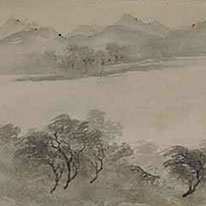Past Exhibitions
- Muqi Fachang and Related Painters
- January 2, 2020 - January 26, 2020
The monk painter Muqi Fachang (act. mid- to late 13th c.) from Sichuan
was probably one of the most important Chinese painters who influenced
the development of Japanese ink painting. Muqi is said to have been a
disciple of the Chan master Wuzhun Shifan (1177–1249) and was associated
with the founding of Liutong monastery near West Lake.
In Japan, Muqi's monochrome ink paintings were highly appreciated and
collected. This was in contrast to his reception in China, where the
popularity of his paintings lasted only temporary. His works in light ink
were described as being in the "Muqi mode," which referred to the
"boneless method" of painting that did not make any use of ink outlines. In
Japan, the painter was so famous that even if he was referred to only as the
"High Priest," everyone would know that Muqi was meant.
This section introduces the profound world of Muqi through some of his
prized works coming mainly from Kyoto collections.












